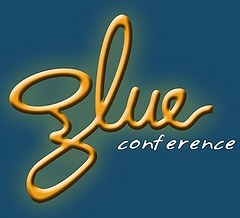-
 What is Glue?
What is Glue? - Definition from the Merriam-Webster Dictionary:
- 1 a: any of various strong adhesive substances ; especially : a hard protein chiefly gelatinous substance that absorbs water to form a viscous solution with strong adhesive properties and that is obtained by cooking down collagenous materials (as hides or bones) b: a solution of glue used for sticking things together
- Hm – not what I am looking for, if you need it, you can buy it here – end of story.
- 2 something that binds together <enough social glue…to satisfy the human desire for community — E. D. Hirsch, Jr.>
-
Social Glue … now we’re getting closer. So again, what is Glue? There are several companies in the software business with
goo-yglue-y products:Glue is Companies and Products
AdaptiveBlue has a browser extension called Glue. (Blue Glue?
 ) VC and Blogger Fred Wilson aptly calls it A Social Net That Lives In Your Browser.
) VC and Blogger Fred Wilson aptly calls it A Social Net That Lives In Your Browser. Then there is Yahoo Glue. And of course there are a bunch of companies that don’t call themselves or their products Glue – they just do it.
Gnip’s mission is elegantly “Making data portability suck less”. Here’s an easy (?) chart explaining what they do:

Boomi is another Glue company, providing integration Platform-as-a-Service (iPaaS – ah, starting 5-letter acronyms
 ). Read their thought-provoking post on Why APIs Don’t Solve the SaaS Integration Challenge.
). Read their thought-provoking post on Why APIs Don’t Solve the SaaS Integration Challenge. MindTouch started their life as a wiki company, and grew into “an open source enterprise collaboration and community platform that enables users to connect and remix enterprise systems, social tools and web services.”. Ouch, that sounds so official – here’s another version from the Chief Conductor who just returned from a major Product Launch:
We do orchestration for a myriad of systems, databases and any web service, all with a easy to use wiki-like interface.
Let’s not forget about Mashery, plumbers of the Web, or more elegantly, a “leading provider of API management services enabling companies to easily leverage web services as a distribution channel.”
The list can go on and on, and even in the current downturn we will see more Glue companies. In fact Glue has become investment theme for some really smart VCs:
Glue is our term for the web infrastructure layer that facilitates the connections between web services and content companies
Glue is a Concept – actually, several concepts
- Enterprise Glue: A "web oriented architecture" and beyond SOA
- Data Glue: Mash-ups, mash-ups and more mash-ups
- Social Network Glue: The movement toward cross-network interoperability and data sharing
- Interface Glue: Cross-platform, cross-browser technologies like Silverlight and Adobe Air
- Messaging Glue: Tools that are evolving for meta-messaging
- Identity Glue: Reputation, user-centric identity and web sso
- OS Glue: Cross-operating system runtimes
- Marketing Glue: The abstraction of the management of ad platforms into a common interface
- Infrastructure Glue: Cloud and Utility computing that binds back-end services
Oh, boy. This is big, way over my head. I better leave this discussion to smarter people who actually understand the technology behind all this.
 But I’ll share a secret: they will all come together in Denver, on May 12-13 of this year. Will you be there?
But I’ll share a secret: they will all come together in Denver, on May 12-13 of this year. Will you be there?Glue is a Great Conference – Get Sticky Now
 I’ve discussed earlier how Defrag was the best Conference I attended for quite a while. The conference Theme, sessions, very active participants, the venue, the infrastructure (working wi-fi, no small feat!) – you name it, it all came together perfectly. So when Defrag’s organizer, Eric Norlin sets out to launch another conference discussing all of the above and more, it’s bound to be a success. Here’s Eric’s summary:
I’ve discussed earlier how Defrag was the best Conference I attended for quite a while. The conference Theme, sessions, very active participants, the venue, the infrastructure (working wi-fi, no small feat!) – you name it, it all came together perfectly. So when Defrag’s organizer, Eric Norlin sets out to launch another conference discussing all of the above and more, it’s bound to be a success. Here’s Eric’s summary:Glue is the only conference devoted solely to solving the web application integration problem-set. People that should attend Glue include the architects, developers, administrators and integrators that have moved past the initial step of seeing the web as a platform, and are facing the real-world challenges of what "stove-piped" web applications mean for their overall strategy. Glue is about all of bits and pieces, APIs and meta-data, standards and connectors that will help us to glue together the varying applications of the new platform.
The Agenda is shaping up, Sponsors are in, and reservations are coming through nicely, recession or not. Like I’ve said, Some Conferences Are Worth Attending Even in Bad Times.

Of course getting a bargain helps in bad times: where else do you get an intense top-notch conference for $395? That is if you catch early bird reservation, so hurry, get sticky now.
By the way, participation does not start in May – you can share ideas right now, I’ll help with resources. CloudAve, my main blogging gig is pleased to be the Media Sponsor for Glue, and you will see a stream of related posts over there as we approach the Conference dates (this may be the right time to grab the CloudAve Feed). We invite everyone interested to participate: please submit your post, we’ll be happy to publish it. And if you prefer to post in your own blog, wiki, Twitter, FriendFeed, Facebook…whatever – just make sure to use the tag gluecon (since glue might find – you know, this). We’ll find your post and pull it under the Glue Tab, which will soon turn into a resource list of all-things-glue.
On a personal level I am stoked to be able to serve on the Glue Conference‘s Advisory Board along with great thinkers like Amy Wohl, Phil Wainewright, Chris Shipley, Mike West, and Albert Wenger. I’m really excited about this Conference, and am looking forward to meeting many of you.
What are you waiting for? Get Sticky Now!

(Cross-posted from CloudAve)

Damn, I Want to be a Developer … in Boulder, Colorado
Too bad I am not. Which is why I don’t qualify for this all expenses paid trip to Boulder:

And the pitch:
Boulder Needs More Kickass Developers
Want a FREE trip to beautiful Boulder, Colorado? The Boulder tech scene is growing like crazy. Twenty of our top tech startups (you can see a few in the sidebar) have banded together to fly in one hundred top software developers, programmers and engineers from across the country, all expenses paid. You can apply to be one of the hundred.
So here we go, getting our daily dose of layoff news, while Boulder startups are in shortage of talent. Good developers are still worth gold … somewhere. (They mine gold in Colorado )
)
Developers. Not Management, Marketing, Sales – not the MBA’s. And that’s the clue to understanding a lot of the differences between the startup world we have today and during the late 90’s bubble.
Back then startups got VC-funded and part of the deal was bringing in “pro” management teams: the MBA-types and former corporate Executives who flooded the Valley in the hope of IPO-riches. Founders found themselves in VP / Director positions, or got pushed out, if not, they were left wondering how their little baby got to hundreds of employees so fast and just what all these new managers were doing with their company. Then the bubble burst, and the imported Exec’s rushed back to the safety of the corporate world leaving the wreckage behind.
Today most Web 2.0 startups are run by the original Founder, often a developer him/herself. This is now the age of the technologist, not the business manager. The roles are reversed. These CEO’s, Founders, team members won’t jump ship – the ship is theirs, and there’s nowhere to run back anyway. One more reason to be optimistic about their survival.
In the meantime, here’s a preview of what it’s like to work in Colorado, also home of TechStars and Defrag (use discount code zoli1 to get $300 off @Defrag)

(Originally posted @ CloudAve. To stay up-to-date on SaaS, Cloud Computing and Business, grab the CloudAve Feed here)


No, the Sky is Not Falling in Startup-land
Lot’s of noise today, RIP Good Times, IT’S OVER! POP GOES THE BUBBLE, Sorry, Startups: Party’s Over etc. I think the panic is overdone.
Sure, a lot of startups will fall – and some of them would have done so without a recession anyway. Times are officially tough, but the truly strong businesses will survive, and some of the Web 2.0 whiz-kid baby-CEOs will come out of this as battle-hardened Entrepreneurs.
Talk about Executives… some can wreck the business on their own, they don’t need a crisis: see Entellium wrecked by fraud.
Finally some startups think they can keep on re-architecting forever – see NetBooks, ViewPath (the latter just came out with a new product though.) Good luck to them… wonder if their market runs away…
These are some of the thoughts I’m discussing on CloudAve today – read more here. Even better, grab the feed here.

Update: Want to get off the “Sky is falling” treadmill? Need inspiration? Find it here.
Even better, get really inspired at Defrag. Use discount code zoli1 to get $300 off.
.

Recent Comments